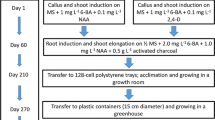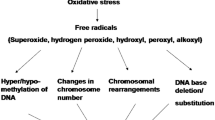Summary
Seventy-two plants regenerated from leaf-derived calli of a single plant of Lotus corniculatus have been evaluated for several morphological and agronomical traits. The analysis of selfed and polycross progenies of the regenerants indicates that the variation among regenerants was, at least in part, of genetic origin. Most of the mutations induced by tissue culture were recessive and were detected only after sexual propagation. Although in vitro culture had a depressive effect for most of the traits, the selfed progenies of 2 regenerants displayed higher values for leaflet width and seed yield than the selfed progeny of the initial plant. However the somaclonal variation did not increase the variation for any trait with respect to the variation of the donor cultivar of the initial plant.
Similar content being viewed by others
References
Ahloowalia, B.S., 1986. Limitations to the use of somaclonal variation in crop improvement. In: J., Semal (Ed.): Somaclonal variation and crop improvement. Martinus Nijhoff Publishers Dordrecht, Boston, Lancaster.
Arcioni, S., D., Mariotti, F., Damiani & M., Pezzotti, 1986. Somaclonal variation in Lotus corniculatus L. In: W., Horms, C.S., Jensen, W., Odenbach & P., Schieder (Eds): Genetic manipulation in plant breeding-Walter De Gruyter-Berlin, New York pp. 581–584.
Armstrong, K.C., C., Nakamura & W.A., Keller, 1983. Karyotype instability in tissue culture regenerants of triticale (X Tritico secale Wittmack) cv. ‘Welsh’ from 6-month-old callus cultures. Z. Pflanzenzücht 91: 233–245.
Bingham, E.T., 1979. Maximizing heterozigosity in autopolyploids. In: W.H., Lewis (Ed.), Polyploidy, pp. 471–489. Plenum Press, New York-London.
Brettel, R.I.S., E.S., Dennis, W.R., Scowcroft & W.J., Peacock, 1986. Molecular analysis of a somaclonal mutant of maize alcohol dehydrogenase. Mol. Gen. Genet. 202: 235–239.
Burton, G.W. & E.H.De, Vane, 1953. Estimating heritability in tall fescue (Festuca arundinacea) from replicated clonal material. Agron. J. 45: 478–481.
Casler, M.D., 1982. Genotype x environment interaction bias to parent-offspring regression heretability estimates. Crop. Sci. 22: 540–542.
Damiani, F., D., Mariotti, M., Pezzotti & S., Arcioni, 1985. Variability among plants regenerated from tissue culture of Lotus corniculatus L. Z. Pflanzenzüchtg 94: 332–339.
Evans, D.W., 1986. Somaclonal and gametoclonal variation. In: P.C., Augustine, H.D., Danforth & M.R., Bakst (Eds.). Belts-ville symposia in Agricultural Research 10. Biotechnology for solving Agricultural Problems. Martinus Nijhoff Publishers, Dordrecht, Boston, Lancaster, pp. 63–96.
Flashman J.M., 1982. A study of genetic instability in tobacco callus culture. In: A. Fujiwara (Ed.): Proc. 5th Int. Cong. Plant Tissue and Cell Culture, p 411–412.
Hanna, W.W., C., Lu & I.K., Vasil, 1984. Uniformity of plants regenerated from somatic embryos of Panicum maximum Jacq. (Guinea grass). Theor. Appl. Genet. 67: 155–159.
Johnson, L.B., D.L., Studeville, S.E., Schalarbaun & D.Z., Skinner, 1984. Variation in phenotype and chromosome number in alfalfa protoclones regenerated from nonmutagenized calli. Crop Sci. 24: 948–951.
Larkin, P.J., S.A., Ryan, R.I.S., Brettel, & W.R., Scowcroft, 1984. Heritable somaclonal variation in wheat. Theor. Appl. Genet. 67: 433–455.
Larkin, P.J. & W.R., Scowcroft, 1981. Somaclonal variation—a novel source of variability from cell cultures for plant improvement. Theor. Appl. Genet. 60: 197–214.
Mariotti, D., M., Pezzotti, E., Falistocco & S., Arcioni, 1984. Plant regeneration from leaf-derived callus of Lotus corniculatus L. cv. Franco. Genet. Agr. 38: 219–223.
McCoy, T.J., R.L., Phillips & H.W., Rines, 1982. Cytogenetic analysis of plants regenerated from oat (Avena sativa) tissue cultures: high frequency of partial chromosome loss. Can. J. Genetic. Cytol. 24: 37–50.
Onokpise, O.U., S.R., Bowley, D.T., Tomes & B.E., Twameley, 1987. Evaluation of self and polycross progeny testing in birdsfoot trefoil (Lotus corniculatus L.) for forage and seed yield. Plant Breeding 98: 141–148.
Orshinsky, B.R. & D.T., Tomes, 1984. Comparison of plants derived from cuttings, node cultures and ethyl methanesulfonate treated node cultures of bird's-trefoil (Lotus corniculatus). Can. J. Bot. 62: 1501–1504.
Orshinsky, B.R. & D.T., Tomes, 1985. Effect of long-term culture and low temperature incubation on plant regeneration from a callus line of birdsfoot trefoil (Lotus corniculatus L.). J. Plant Physiol. 119: 389–397.
Orton, T.J., 1984. Somaclonal variation: theoretical and practical application. In: J.P., Gustafson (Ed.): Gene manipulation in plant improvement. Plenum Press, New York, London, pp. 427–468.
Pezzotti, M., S., Arcioni, F., Damiani & D., Mariotti, 1985. Time related behaviour of phenotypic variation in Lotus corniculatus regenerants under field conditions. Euphytica 34: 619–623.
Powell, W., A.M., Hayter, W., Wood, J.W., Dunwell & B., Huang, 1984. Variation in the agronomic characters of microspore-derived plants of Hordeum vulgare cv. Sabarlis. Heredity 52: 17–23.
Scowcroft, W.R., 1985. Somaclonal variation: the myth of clonal uniformity. In: B., Hohn & E.S., Dennis (Eds.). Genetic flux in plants. Springer. Wien New York, pp. 217–245.
Shepard, J.F., D., Bidney & E., Shahin, 1980. Potato protoplasts in crop improvements. Science 208: 17–24.
Swanson, E.B. & D.T., Tomes, 1980. Plant regeneration from cell culture of Lotus corniculatus and the selection and characterization of 2–4 D tolerant cell-lines. Can. J. Bot 58: 1205–1209.
Author information
Authors and Affiliations
Rights and permissions
About this article
Cite this article
Damiani, F., Pezzotti, M. & Arcioni, S. Somaclonal variation in Lotus corniculatus L. in relation to plant breeding purposes. Euphytica 46, 35–41 (1990). https://doi.org/10.1007/BF00057616
Received:
Accepted:
Issue Date:
DOI: https://doi.org/10.1007/BF00057616




